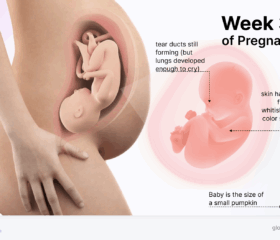Water Breaking: Signs and What to Do When It Happens
Fewer signs of labor are as characteristic as your water breaking. When it happens, your baby is on her way.

- What does "water breaking" really mean?
- What's the connection between your water breaking and contractions?
- What does your water breaking feel like?
- What if your water doesn’t break?
- What to do when your water breaks: a step-by-step guide
- How to tell the difference between amniotic fluid, urine, and discharge
- Final thoughts
You probably imagine your water breaking as a sudden and dramatic event that signals the start of labor. In reality, it’s often far subtler than that.
In this article, we’ll break down exactly what you can expect when your water breaks and how to recognize the signs that it’s happened.
What does "water breaking" really mean?
When people talk about your water breaking, they’re referring to the rupture of the amniotic sac, the fluid-filled membrane that cushions and protects your baby throughout your pregnancy. This sac is made up of two layers, and when they tear, amniotic fluid leaks out. 1
While your water breaking is one of many signs of labor, it can happen well before labor begins (potentially days before). Nearly 15% of pregnant women experience their water breaking before their contractions start. 2
Your water may also break during labor, and in some cases, it might not happen on its own at all, meaning your doctor may have to rupture your amniotic sac manually.
How does the amniotic sac rupture?
Your membrane rupturing is a natural part of labor. As your body gears up for birth, enzymes weaken the amniotic sac, which eventually causes it to break and release the fluid inside.
This generally happens late in the third trimester, when your baby is fully developed and is just about ready to be born. 3
What's the connection between your water breaking and contractions?
Again, in some cases, you’ll get contractions before your water breaks. In fact, the force of active labor contractions can themselves rupture the membranes.
Other times, the opposite happens—your water breaks first, and contractions follow. This is known as “premature rupture of membranes” (PROM). 4
If you’re at least 37 weeks pregnant, your water breaking usually means labor will start soon.
Preterm premature rupture of membranes (PPROM)
If your amniotic sac breaks before you reach 37 weeks, this is known as preterm premature rupture of membranes (PPROM). 2
This can be a problem, as your baby’s lungs and other organs may still be developing. Don’t panic—doctors have ways of handling this. However, it’s important that you get medical attention right away.
Risk factors for PPROM
Various conditions and risk factors can increase your odds of having PPROM, including: 1
- Infection of the amniotic sac
- Carrying multiples (twins, triplets, etc.)
- Having a weakened cervix
- Infections (vaginal, cervical, bladder, kidney, or sexually transmitted)
- Vaginal bleeding during pregnancy (e.g., having had a subchorionic hemorrhage)
- Having too much amniotic fluid (polyhydramnios) 5
- Smoking
- Poor nutrition
- Excessive physical activity
- Bacterial vaginosis, which can make the membranes more fragile
If you have a history of your water breaking early in previous pregnancies, that’s also a risk factor. If it’s happened once, it’s statistically more likely to happen again.
How is PPROM treated?
The right treatment for PPROM depends on how far along you are. If there’s no sign of infection or distress from your baby, your doctor may try to prolong your pregnancy. On the other hand, if there is an infection brewing or there’s some other reason to end your pregnancy early, they may try to induce labor or recommend a C-section.
If you don’t have to give birth right away, your doctor may give you antibiotics to prevent infections, as well as steroids to help your baby’s lungs mature more quickly. This will help if they do have to be born early. They may also give you magnesium sulfate to protect your baby’s brain. 4
What does your water breaking feel like?
When your water breaks, you may feel a rush of warm fluid, similar to peeing involuntarily. You might also feel a small “pop” or a moment of pressure in your abdomen.
In contrast to what you’ve probably seen in movies, your water breaking also might not be particularly dramatic. It might just feel like a slow trickle of fluid that doesn’t stop. In fact, you may even think you’re peeing, although the smell (or lack of it) should provide a clue that it isn’t urine.
Note that if your water doesn’t break until you’re already in labor (with your contractions in full swing), it’s possible you won’t even notice it’s happening, especially if you have an epidural.
How much amniotic fluid will you release when your water breaks?
The amount of fluid released during this event varies. At full term (40 weeks pregnant), you’ll have about 600 ml of amniotic fluid. 6
If your baby’s head is low in your pelvis, it might block some of the fluid, making it seem like a smaller leak. This is nothing to be worried about. However, if you have a small gush that stops, this could mean your membranes ruptured and then resealed. Let your doctor know right away if this happens, since it can lead to an infection. 7
What does amniotic fluid look and smell like?
Normally, amniotic fluid is clear. It may also be slightly cloudy due to vernix, the protective coating on your baby’s skin, which she’ll mostly shed before labor. 8
If the fluid is green, yellow, or brown, it could mean your baby has passed meconium (her first stool). In this case, you need to let your doctor know immediately, as it could be a sign that your baby is sick or distressed.
Amniotic fluid usually has a mildly sweet or salty scent. If your pregnancy discharge is yellow and strong or foul-smelling, that could indicate an infection, and you should let your doctor know. 8
How long after your water breaks will your baby be born?
There’s no exact answer to this question—every pregnancy is different. If your contractions have started, it means your labor is progressing.
Be aware that if there’s a significant lag between your water breaking and your contractions starting, your doctor may consider induction to reduce your risk of contracting an infection, although they’ll probably wait a few hours before taking that step.
If your water breaks before 37 weeks, the reverse may be true: your doctor might try to take steps to prolong your pregnancy and give your baby longer to develop. If so, you might need to be hospitalized so that they can observe your condition closely. 9
Don’t confuse your water breaking with bloody show
When your labor is approaching, you may also see a small amount of blood-tinged mucus (“bloody show”) discharge from your vagina. Don’t confuse this with your water breaking—it’s a different thing, although it appears around the same time. Bloody show alarms some expecting mothers, but it’s perfectly normal. However, if you see bright, red blood or brownish pregnancy discharge, that could signal a complication like placental abruption, and you should tell your doctor about it. 10
What if your water doesn’t break?
Sometimes, if your labor is delayed (your pregnancy has gone past 40 weeks), your doctor might decide to jumpstart it. If so, they might manually break your water with an amniotomy, or artificial rupture of membranes (AROM).
This is what it sounds like: when your doctor manually breaks your water to encourage labor. 11 They’ll only do it if your cervix is ready and your baby is low in your pelvis. While this process can speed up labor, it does slightly increase your risk of infection. 11
If you get an amniotomy, your doctor will manually rupture your amniotic sac with a small hook. This usually won’t hurt, and once your doctor has ruptured the amniotic sac, your contractions should start to amp up. 11
What to do when your water breaks: a step-by-step guide
Once your water breaks, here’s what to do next:
- Call your doctor: First, let your doctor know your water has broken. They’ll let you know what your next steps should be, depending on your pregnancy stage and symptoms.
- Track the time: Make sure you note when your water broke. As mentioned, prolonged rupture increases your risk of infection.
- Check the fluid: Take a look at the fluid’s color and smell and share these details with your doctor.
- Practice good hygiene: Use pads—never tampons—to absorb the fluid. 12 Keep your vaginal area clean, and always wipe from front to back. If you’re sexually active, you’ll need to put sex on hold for now, even if you don’t go into labor immediately.
- Head to the hospital or birth center: At this point, your doctor will probably tell you to come in. Pack your essentials and go!
When to call your doctor
Usually, after your water breaks, your labor will progress as normal. However, in some cases, your water breaking needs immediate medical attention. As mentioned, any strange colors in your amniotic fluid or your stream of fluid suddenly stopping warrants an immediate trip to the doctor’s office or hospital.
You should also call your doctor if your baby isn’t in a head-down position yet, as your delivery might require special management (e.g., a C-section). 13
Let them know if you feel something in your vagina or see part of the umbilical cord, which can be a sign of umbilical cord prolapse. This is rare, but it can be life-threatening for your baby. 14
What if your water breaks and you don’t have contractions?
Most women start contractions within 12–24 hours of their water breaking. 9 If you don’t, your doctor will likely induce labor to help prevent infection.
How to tell the difference between amniotic fluid, urine, and discharge
It can be tricky to tell whether you’re actually leaking amniotic fluid or whether you’re seeing regular pregnancy discharge or a bit of urine (since incontinence can be a symptom of pregnancy).
Here’s how to tell the difference: 3 15
Differences between amniotic fluid, urine, and vaginal discharge
| Fluid | Color | Consistency | Odor | Leaks |
|---|---|---|---|---|
| Amniotic fluid | Clear | Thin or watery | Odorless or mildly sweet or salty | May be continuous or a slow trickle |
| Urine | Yellowish | Thin or watery | Ammonia smell | With movement |
| Vaginal discharge | Clear or milky white | Thick (mucus) | Mild or musky smell | Varies |
Final thoughts
Again, your water breaking may be a much more low-key affair than movies and TV shows have led you to expect.
If you’re nervous about this telltale sign of labor, don’t be. In all likelihood, it won’t be unpleasant or scary, and not long after it happens, you’ll finally get to meet your baby.
Article Sources
- StatPearls. "Preterm and Term Prelabor Rupture of Membranes (PPROM and PROM)" Retrieved May 20, 2025.
- Cleveland Clinic. "Premature Rupture of Membranes" Retrieved May 20, 2025.
- Office on Women's Health. "Labor and birth" Retrieved May 20, 2025.
- MedlinePlus. "Premature rupture of membranes" Retrieved May 20, 2025.
- MedlinePlus. "Polyhydramnios" Retrieved May 20, 2025.
- MedlinePlus. "Amniotic fluid" Retrieved May 20, 2025.
- University of Rochester Medical Center. "Preterm Premature Rupture of Membranes (PPROM)" Retrieved May 20, 2025.
- Cleveland Clinic. "Amniotic Fluid" Retrieved May 20, 2025.
- MedlinePlus. "Am I in labor?" Retrieved May 20, 2025.
- MedlinePlus. "Placenta abruption - definition" Retrieved May 20, 2025.
- MedlinePlus. "Inducing labor" Retrieved May 20, 2025.
- MedlinePlus. "Vaginal bleeding in early pregnancy" Retrieved May 20, 2025.
- MedlinePlus. "Breech birth" Retrieved May 20, 2025.
- Obstetrical & Gynecological Survey. "Umbilical Cord Prolapse: A Review of the Literature" Retrieved May 20, 2025.
- Cleveland Clinic. "Vaginal Discharge" Retrieved May 20, 2025.







